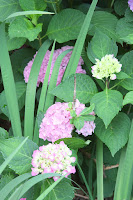Layer Perennials to Make More Plants
Lots of perennials can be layered to make more plants. While some recommend doing it in the spring, I've had good luck starting the process in late summer and early fall, too.
Basically, what you'll do is select a lower branch of a healthy plant and put it on the soil. Once you know where on the branch the soil will intersect, you remove all the leaves from that area and scar it by scraping the outer bark near a leaf node.
That leaf node/scarred area is placed on the soil and gently pressed in. To keep the rooting site in contact with the soil put soil or newspaper on top then anchor it with a rock.
You can also pin the branch's leaf node area to the soil after removing the leaves and slightly scarring it. Called simple layering.
Some recommend air layering by wrapping the stem but that method has never worked for me.
Plants to consider layering method include roses, Beautyberry, Blackberry, Snowball shrub, Pyracantha, Hibiscus, Holly, Laurel, Lavender, Creepers, Forsythia, Azaleas, and many houseplants.
You can also do tip layering. Dig a 3-inch hole and insert a shoot tip and cover it. The tip grows down then bends and comes back up.
Layering is easy and it's a kick to see all the new plants you'll have available next spring.
Basically, what you'll do is select a lower branch of a healthy plant and put it on the soil. Once you know where on the branch the soil will intersect, you remove all the leaves from that area and scar it by scraping the outer bark near a leaf node.
That leaf node/scarred area is placed on the soil and gently pressed in. To keep the rooting site in contact with the soil put soil or newspaper on top then anchor it with a rock.
 |
| Simple layering |
Some recommend air layering by wrapping the stem but that method has never worked for me.
 |
| Tip layering |
You can also do tip layering. Dig a 3-inch hole and insert a shoot tip and cover it. The tip grows down then bends and comes back up.
Layering is easy and it's a kick to see all the new plants you'll have available next spring.



Comments